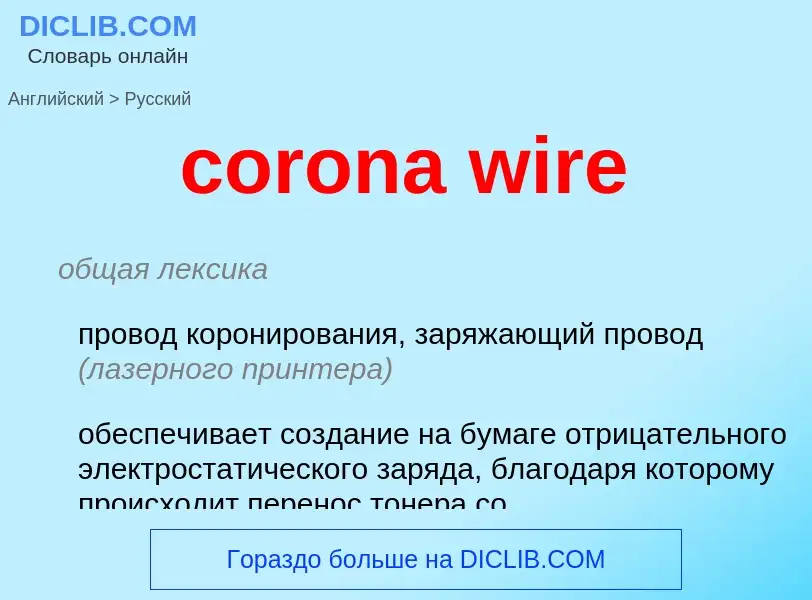Translation and analysis of words by ChatGPT artificial intelligence
On this page you can get a detailed analysis of a word or phrase, produced by the best artificial intelligence technology to date:
- how the word is used
- frequency of use
- it is used more often in oral or written speech
- word translation options
- usage examples (several phrases with translation)
- etymology
corona wire - translation to russian
общая лексика
провод коронирования, заряжающий провод (лазерного принтера)
обеспечивает создание на бумаге отрицательного электростатического заряда, благодаря которому происходит перенос тонера со светочувствительного барабана, где лазером сформировано изображение для печати
Смотрите также
общая лексика
коронный (электрический) разряд
физика
коронирующий разряд
Wikipedia
A corona discharge is an electrical discharge caused by the ionization of a fluid such as air surrounding a conductor carrying a high voltage. It represents a local region where the air (or other fluid) has undergone electrical breakdown and become conductive, allowing charge to continuously leak off the conductor into the air. A corona discharge occurs at locations where the strength of the electric field (potential gradient) around a conductor exceeds the dielectric strength of the air. It is often seen as a bluish glow in the air adjacent to pointed metal conductors carrying high voltages, and emits light by the same mechanism as a gas discharge lamp.
In many high voltage applications, corona is an unwanted side effect. Corona discharge from high voltage electric power transmission lines constitutes an economically significant waste of energy for utilities. In high voltage equipment like cathode ray tube televisions, radio transmitters, X-ray machines, and particle accelerators, the current leakage caused by coronas can constitute an unwanted load on the circuit. In the air, coronas generate gases such as ozone (O3) and nitric oxide (NO), and in turn, nitrogen dioxide (NO2), and thus nitric acid (HNO3) if water vapor is present. These gases are corrosive and can degrade and embrittle nearby materials, and are also toxic to humans and the environment.
Corona discharges can often be suppressed by improved insulation, corona rings, and making high voltage electrodes in smooth rounded shapes. However, controlled corona discharges are used in a variety of processes such as air filtration, photocopiers, and ozone generators.


![Schwitzerland]]) in foggy weather conditions (long time exposure 30 seconds). Schwitzerland]]) in foggy weather conditions (long time exposure 30 seconds).](https://commons.wikimedia.org/wiki/Special:FilePath/Koronaentladungen an Hochspannungsleitung.jpg?width=200)

![Corona discharge from a spoon attached to the high voltage terminal of a [[Tesla coil]]. Corona discharge from a spoon attached to the high voltage terminal of a [[Tesla coil]].](https://commons.wikimedia.org/wiki/Special:FilePath/Nje shkarkese korone ne nje luge.jpg?width=200)
![Corona discharge on a [[Wartenberg wheel]] Corona discharge on a [[Wartenberg wheel]]](https://commons.wikimedia.org/wiki/Special:FilePath/Plasma wheel 2 med DSIR2018.jpg?width=200)

